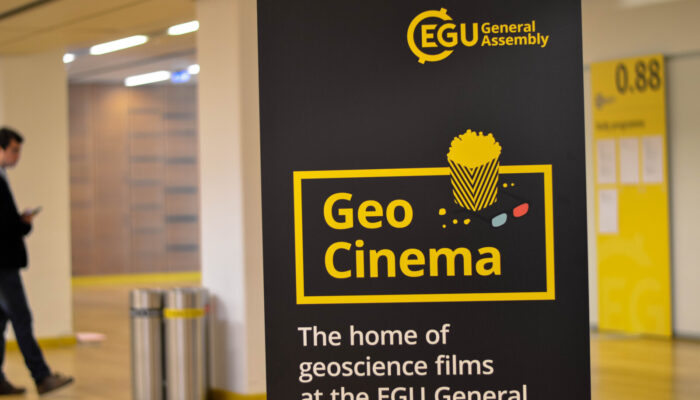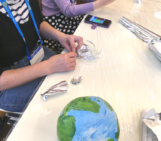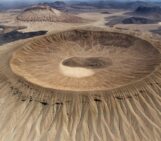
After a six year hiatus, GeoCinema is back for EGU24! As many of you know, doing science is very rarely just about the research, but also involves sharing that research in several forms and formats. For many talented researchers this means using films. Either working with a film-maker or creating something themselves, several of our EGU24 attendees submitted wonderful films this year, from science in the lab or fantastic spectacles in the field, to producing educational features on the Earth, planetary or space sciences and even a feature film produced and narrated by actor Jason Momoa! Selecting films on a first-come-first-served basis that met our criteria and standard of quality, we co-ordinated 14 films that will be screened on-site, followed by a short Q&A with the author, and an additional eight films which can be watched on demand at any time.
GeoCinema sessions will take place in room E1 at the Austria Center Vienna (ACV) on Monday, Tuesday, Thursday and Friday of the conference week, between 18:00 and 20:00 CEST. The room is equipped with a hybrid set-up, allowing us to live-stream the films to our virtual audience in addition to those on-site in Vienna.
If you can’t wait to get started, why not take a look at the online archive, with films that explore all facets of geoscience from ocean depths to outer space, submitted to GeoCinema in the past.
Read on for a full description for each of our on-site and on-demand films featured in GeoCinema EGU24!
On-site films
Guardians of the Andes: A tale of water and resilience in Bolivia
Mon, 15 Apr, 18:10–18:25 CEST
Convener: Grisel Jimenez Soto
Divisions: CL, EOS, HS
The documentary explores the geological marvels of Bolivia, specifically focusing on the Andes and the challenges faced by high-altitude communities. Journeying through La Paz, the highest capital in the world, it unveils the symbiotic relationship between humanity and the Andean peaks. The video delves into the mysteries of glacial lagoons, such as the Glacial Lagoon of Cuchill Khunu and Lake Ventanani, showcasing the resilience of rock glaciers amidst climate change. As the video navigate challenging terrains, the documentary highlights the urgent need to preserve these hidden water stores. It emphasizes the interconnected destiny of nature and humanity in the face of glacier retreat and climate-induced changes. The story of Bolivia’s rock glaciers becomes a narrative of survival and adaptation, echoing a call to safeguard shared water resources globally. La Paz’s triple threat of population growth, glacier retreat, and climate changes serves as a microcosm of the broader, pressing issue of reduced water security, demanding collective solutions.
The Cumbre Vieja eruption, La Palma
Mon, 15 Apr, 18:30–18:40 CEST
Conveners: Nicolas Oestreicher, Charline Lormand
Divisions: EOS, GMPV, NH
This short documentary follows a team of volcanologists from the University of Geneva (UNIGE) as they head to the 2021 Cumbre Vieja Eruption on the Island of La Palma, Spain. Working alongside the local INVOLCAN observatory, who was monitoring the evolution of eruption, the UNIGE volcanologists focused more on sampling and analysing the ash and lava flows which can then be compared against historical eruptions. The scientists explain how investigating the mineral and glass content of the fossil and current lava will offer better insight into how eruptions of this type evolve. Film produced by SciencEscape, a Swiss association created by researchers in natural sciences from the University of Geneva.
Lost Lands
Mon, 15 Apr, 18:45–19:05 CEST
Convener: Julian Leyland
Divisions: ERE, GM, HS, ITS
Cambodia’s appetite for sand has exploded as construction continues to fuel economic growth in the capital Phnom Penh. But as the thirst for sand grows, so does the uncertainty over the future of the river. Lost Lands follows two families in Cambodia as they’re left to bear the consequences in the wake of the country’s rapid development. The documentary was produced by the Shifting Sands team to put a human perspective on their research. As sand mining booms on the Mekong, what’s at stake for the millions of communities who rely on the river?
Rivers of Hope
Mon, 15 Apr, 19:10–19:20 CEST
Convener: Daniel Parsons
Divisions: CL, EOS, HS, NH
Come with us as we take you on a sustainability voyage along the Red River in Northern Vietnam. Our film takes you on an emotional journey to connect with place, relationships and meaning(s) to deepen the understanding of how people are living with the impacts of climate change and how actions at a local level are key to future adaptation plans and why youth and intergenerational community dialogues are central to this. Our film was produced to communicate the co-understanding of the geosciences developed between Vietnamese youth and a team of international researchers advanced during our British Academy funded project exploring climate change driven hydrological extremes within the Red River Catchment. The project utilised four core principles which included the centrality of youth for sustainable climate action, the utilisation of participatory action research to deepen understanding(s), the importance of intergenerational and intercultural learning through community-based dialogue and the role of creativity and innovation in building climate action and community resilience into the future. The project helped to cultivate youth-led perspectives and foster climate action by addressing the challenges encountered by the communities and additionally explored the ways in which local, traditional, and indigenous knowledge can enhance understanding and strengthen local action and thus build local societal resilience. This transdisciplinary project entailed scaffolding social science research skills and education alongside geoscientific insights and knowledge of climate change and hydrology, empowering youth to capture and analyse a myriad of diverse local knowledges. Our youth researchers were trained in storytelling techniques so they could tell their story.
The Colours of Luz Beach + Tides
Mon, 15 Apr, 19:30–19:45 CEST
Convener: Luís Azevedo Rodrigues
Divisions: AS, CL, EOS, GM, SSP
The video “The Colours of Luz Beach” details the unique geology of Praia da Luz (Lagos, Portugal), highlighting the varied sedimentary, magmatic and metamorphic rocks. It emphasises the different colours and compositions due to the distinct minerals and millennia-old geological processes. The article delves into geological history, going back to the Cretaceous period, and analyses how the geological and climatic conditions of that time influenced the formation of these rocks, contributing to the unique and colourful landscape of the beach today. The video “Tides” is the outcome of a creative process developed between a palaeontologist and a designer, and the product is a combination of a vision of the Earth’s history and the current aesthetic that tourists enjoy on this Algarve beach. This video was created from Luís Azevedo Rodrigues’ popular science article in “Revista Dois” and is the result of creative cooperation between the author (a palaeontologist and director of a science museum) and designer Ana Amaral. The video deals mainly with tides and their impact on the Earth and life, focusing on tides, their formation by the gravity of the Moon and the Sun, and their effects on the Earth and marine life. It examines the influence of tides on ecosystems, the evolution of tetrapods and historical changes in tides, emphasising their ecological and evolutionary relevance. The video also touches the role of tides in altering the length of terrestrial days and explores historical variations in tides and their link to important evolutionary events.
Special screening, feature film: DEEP RISING
Tue, 16 Apr, 18:15–20:00 CEST
Convener: Sandor Mulsow
Divisions: CL, ERE, GI, OS
Join us on an epic journey from the deepest depths of our ocean – the most uncharted and inaccessible place on our planet – to the future of green energy, and learn how the two are inextricably linked. Narrated and executive produced by Jason Momoa, and interwoven with awe-inspiring footage of the deep’s most dazzling creatures, Deep Rising illuminates the vital relationship between our ocean’s fragile and mysterious ecosystems, and sustaining all life on Earth. A riveting tale of geopolitical, corporate and scientific intrigue, the film exposes the inner workings of the International Seabed Authority (ISA): a secretive United Nation instrument which oversees nearly half our planet’s surface on the ocean floor. The ISA is empowered to greenlight the massive extraction of metals from the seabed which are deemed essential by some to fulfill demand for the current electric battery technology. As extractive conglomerates pivot investments from oil and gas to deep-ocean mining, Deep Rising asks why we don’t instead choose to develop abundant resources to solve our growing energy demands. Deep Rising reminds us that the seabed is the common heritage of humankind and highlights the urgent need to make the right decision for generations to come.
Convener: Giuliana Panieri
Divisions: BG, EOS, GMPV, ITS, OS
EMBracing the Ocean artists-in-resident, Rhoda and Mikkel are working with Ocean floor sediment from extreme environments, in collaboration with Professor Giuliana Panieri and other scientists from the Department of Geosciences at the Arctic University of Norway. During their residency, they are creating glass cores from sediment samples to research the diversity of organic matter and mineral content with varying locations, seasons, depths and ecosystems. They seek to connect audiences to life in extreme environments such as methane and hydrothermal ocean vents across deep time perspectives. Through this research and artwork, they hope to create a possibility for audiences to empathise with the vibrancy of life in the Ocean that existed before our existence and continue to adapt and evolve and get an insight into the layered stories and histories around us. Learn more about their project here. The film is made by IDOART Agency.
Pascotin
Thu, 18 Apr, 18:25–18:35 CEST
Convener: Stefano Poli
Divisions: GMPV, GD, SSP, TS
Find out how folds form in rocks by watching Pascotin’s story. This is a fascinating narrative about the ability to shape matter, from the artistic manipulation of glass to the geological folds in rocks created by natural forces. “Professor” Pascotin emerges as a master in the art of glasswork, transforming it into extraordinary pieces of art. The description of folds in rocks, generated by subterranean forces pushing and bending the Earth’s crust, provides a captivating insight into the geological process. The mention of the Alps being lifted by the push of Africa against Europe adds a touch of drama and illustrates how the Earth itself is an artist in shaping its features. The inclusion of fossils, minerals, and rock fragments as witnesses to geological history adds an educational and scientific element to the narrative. The relationship between inclusions and geological history, from determining the age of rocks to the dynamics of mountain ranges, highlights the wealth of information nature can provide through its creations. Finally, the expansion to the atomic scale promises further exploration into scientific discoveries, suggesting that the wonders of matter can be investigated at microscopic levels. This narrative conveys the beauty and complexity of nature, emphasizing the power of geology in shaping our world.
A deep movie
Thu, 18 Apr, 18:35–18:45 CEST
Convener: Elena Popova
Divisions: BG, CR, OS
An artistic interpretation of the experience of a long research ice-drifting expedition in the Central Arctic Ocean. An inside look at the work in a severe polar region for those desiring to dive under the ice. The film is made onboard a vessel – including music, editing, etc.
Tsunami 11th Relative
Thu, 18 Apr, 18:50–19:20 CEST
Convener: Pieter Romer
Divisions: OS, SM, TS
Learn about the rich history of tsunami resilience on the Pacific West Coast, and how combining traditional Indigenous Knowledge with ocean science can better prepare communities for the next “big one”, as shown in the new documentary Tsunami 11th Relative. The Ocean Networks Canada (ONC) supported documentary shares Indigenous Knowledge of past ‘great saltwater floods’ that reached northwest Vancouver Island, told through a tapestry of stories set against the backdrop of the rich, natural beauty of Vancouver Island, British Columbia. One of these stories includes a magnitude nine earthquake that occurred in the Cascadia subduction zone on January 26, 1700, producing a tsunami so large it reached the top of mountains. This knowledge has impacted modern practices such as communities’ installing back-up solar power generation on higher ground. Pieter Romer, the documentary producer/director and ONC Indigenous Community Liaison, says Indigenous Peoples’ survival and adaptations in the face of past devastating earthquakes and tsunamis are woven into the stories handed down through generations. “I learned from Nuu-chah-nulth artist, Tim Paul, who was taught by his grandmother, that sky, sun, moon, mountains, rivers, lakes, land, sea, wind and stars are all our relatives. Earthquake/Tsunami is our 11th relative which is intended to teach humility – remind us of our place in this world and that we are the very smallest part of this universe.” The documentary explores the science behind hazard tsunami mapping, with representatives from ONC, Northwest Seismic Consultants and Northwest Hydraulic Consultants explaining how modeling the sea and land surface can help determine the speed and inundation of tsunami waves under different scenarios.
Rola[Stone]
Thu, 18 Apr, 19:25–20:00 CEST
Convener: Marissa Betts
Divisions: EOS, GD, GM
Rola is the Anaiwan word for “stone”. This film explores the inseparable connection between geology, landscapes and culture on Anaiwan Country (Northern Tablelands area of New South Wales, Australia). All places have parallel narratives—the scientific and spiritual, that govern our relationship with them. Woven together, these perspectives invite us to rethink the ways we understand the deep and recent past, present and future of the world around us. Marissa Betts (researcher) teamed up with a professional filmmaker to show the incredible geological history of the area, and how intimately geology and landscape is embedded in Aboriginal culture in Australia. This film won the Geoscience Professionals category in the 2023 Earth Futures Film festival.
Baffin Bay Deglaciation Experiment
Fri, 19 Apr, 18:10–18:25 CEST
Convener: Georg Koszulinski
Divisions: CL, EMRP, OS, SSP
Over the course of a month at sea, an international team of scientists attempt to gain insights into the Earth’s last deglaciation period. Around 15,000 years ago, the western margin of the Greenland Ice Sheet destabilized and then retreated at an accelerated rate, but the reasons for this rapid deglaciation remain unclear. The Baffin Bay Deglaciation Experiment (BADEX) seeks a greater understanding of this paleoclimate event, in the hopes of gaining deeper insights into climate change today.
SEA-SEIS EXPEDITION 2020
Fri, 19 Apr, 18:30–18:45 CEST
Convener: Raffaele Bonadio
Divisions: GD, SM
A short “digital ship-logbook” shows what happened to the SEA-SEIS Team during the 2018 SEA-SEIS Expedition in the North Atlantic Ocean on board of the Celtic Explorer vessel. The team had to bear with very rough sea, however, they managed to successfully deploy 18 seismometers on the bottom of the ocean, and enjoy the adventure! The SEA-SEIS Team was back on board the Celtic Explorer in April, 2020 amid the Covid-19 pandemic, for the retrieval of the 18 seismometers left at the bottom of the ocean. The video delves into the research objectives, offering insights into the unique experience of living at sea, far from home and family for weeks. It explores the difficulties and hardships of life aboard the vessel and the deep gratification from the extraordinary adventure!
Bonus film: SEA-SEIS Art 2018
The video is a collection of drawing and songs submitted for the SEA-SEIS drawing and song/rap competition by primary and secondary schools pupils. The project SEA-SEIS (Structure, Evolution And Seismicity of the Irish offshore) kicked off in 2018 with a 3-week expedition on the research vessel (RV) Celtic Explorer in the North Atlantic. Secondary and primary school students were invited to participate and help scientists in the research project, which got the students enthusiastically engaged. In a nation-wide competition before the expedition, schools from across Ireland gave names to each of the seismometers. The follow-up survey showed that the engagement was not only exciting but encouraged the students’ interest in science, technology, engineering, and mathematics (STEM) and STEM-related careers.
The great discovery
Fri, 19 Apr, 18:45–19:00 CEST
Convener: Hassan Baghbani
Divisions: AS, BG, CL, EOS, ERE, GM, HS, SSS, SSP
This film is the result of my 23 years of exploration, so it shows a significant discovery in the field of geology, which sheds light on the main causes of the current problems of the Earth, such as global warming and soil erosion. The film aims to show the past conditions of the planet and depict the hot and dry climate several thousand years ago. This ancient method of making billions of traces farming by our ancestors explores their efforts to manage water and soil for agriculture and planting. To enhance the narrative, we used on-location recording, aerial videography, and blending Google Earth data to make it easier for the viewer to understand.
On-demand films
The following films can be enjoyed on-demand during the General Assembly through the Art-Science gallery of EGU24’s virtual platform Gather.Town, or by clicking the links!
AKMA III – Advancing Knowledge on Methane in the Arctic
Divisions: BG, EOS, GMPV, ITS, OS
This short documentary shows some of the key moments of the AKMA III expedition (April 29-May 10, 2023) on board RV Kronprins Haakon. Especially, this oceanographic expedition led by scientists from UiT- The Arctic University of Norway, in partnership with REV Ocean, has discovered the second-ever mud volcano found within Norwegian waters, the Borealis Mud Volcano. This unusual geological phenomenon was discovered with the piloted submersible vehicle ROV Aurora in the Southwestern Barents Sea at the outer part of Bjørnøyrenna (Outer Bear Island Trough). The high-level science on this cruise also included sea-going training for students to develop their knowledge in collecting, curating, and processing samples and data, providing opportunities to fully engage in Arctic marine science. Many unique samples were taken and they are currently being analysed in labs around the world. ABOUT – The AKMA project is funded by the Norwegian Research Council, n. 287869 – Advancing Knowledge on Methane in the Arctic (AKMA): Norway-USA Collaboration.
Charting Geoarchaeology | Episode 1: What is Geoarchaeology?
Divisions: EOS
In the first video of a planned series on YouTube, Jordan Chapman discusses the difference between the geosciences and archaeology and how they combine to make geoarchaeology! Jordan discusses the definitions used to describe both fields, how each developed, and how the audience can learn more and get involved in geoarchaeology. This video was made by Jordan Chapman for the Black Science Coalition and Institute (B-SCI). B-SCI is a 501c3 nonprofit headquartered in Philadelphia, PA, USA which Jordan co-founded with other Black American scientists. B-SCI uses science communication to inspire audiences, specifically from historically underrepresented backgrounds, to become scientists.
Early Career Scientists Gets a Foot Up
Divisions: OS
A budding oceanographer from Romania recounts the mentoring he received from ocean observing experts during a research cruise on the Black Sea as part of the Horizon EU funded EuroGO-SHIP project. The short documentary also features interviews with senior scientists discussing the importance of mentoring early career scientists to give them a foot up. EuroGO-SHIP aims to improve training and access to shared facilities across Europe to enhance ocean observation, particularly in the area of ship-based hydrography. The film was directed by Anaïs Dyckmans for Seascape Belgium, partners in the EuroGO-SHIP consortium.
Flying High: A Drone’s perspective on the Morteratsch and Pers Glacier
Divisions: CR
Embark on an incredible aerial journey over the Morteratsch and Pers glaciers in Switzerland in this stunning drone footage. Witness the majestic icy landscapes as the drone captures their frozen beauty. Amidst the breathtaking visuals, the video brings attention to the impact of climate change on these natural wonders. Experience the delicate balance between the beauty of nature and the looming threat of climate change in this visually stunning exploration.
Geoscience Connections
Divisions: AS, CL, CR, EMRP, EOS, ERE, GMPV, G, GD, HS, ITS, NH, OS, SM, TS
Geoscience Connections leads you through a fascinating journey through the Earth’s history. The timeline starts from the formation of our planet and across billions of years when humans became Earth’s inhabitants. On the one hand, the intelligent human brain allowed for the development of various brilliant technologies and a complex society. On the other hand, humans have participated in the uncontrolled exploitation of natural resources, and are thought to have caused many problems to other living beings on our planet. IUGG geoscientists help us to better understand Earth processes, bring us hope for the problems humanity faces and solutions towards a more sustainable Earth.
One Microbe At A Time – Changing the oil & gas industry
Divisions: BG, ERE, OS
Europe depends on the import of 96% of its oil and gas consumption from outside the EU. Our oil comes from countries where we cannot influence human rights, fair work and environmental protection. We finance countries like Russia, Kazakhstan, Nigeria, Saudi Arabia, Libya, Algeria who are not acting according to our European values. The “Prospectomics” project is funded by the EU and aims to revolutionize oil and gas production in terms of environmental friendliness and costs, and thus also to promote this unfortunately still relevant energy source in Europe, within the framework of our laws and values. Conventional development of new oil fields requires countless test wells several kilometers deep, severely affecting the seabed ecosystem before even finding the first drop of oil. By examining near-surface microbes, Prospectomics hopes to learn about the oil and gas situation beneath the surface. Certain geomicrobiological techniques have just recently become affordable for large-scale use. You would only have to sample 2 meters of seabed from the ship instead of erecting drilling rigs to penetrate kilometers deep into the seabed. This geomicrobiological approach would protect the environment and financially enable funding within the EU, thereby avoiding our dependence on other countries.
The mysterious ‘speeding up’ glaciers of Svalbard
Divisions: CR
Spectacular Svalbard sits halfway between mainland Norway and the North Pole and is one of the fastest warming places in the Arctic. It is home to glaciers which are “speeding up” in a phenomenon known as surging. This short video takes a look at the work of William Harcourt and his team during a 2 week field campaign in Svalbard in August 2023 where they studied this fascinating process. The team used state-of-the-art remote sensing technologies to map changes in the 3D geometry of the glacier to assess how the ‘surge’ is impacting iceberg calving. They also used seismometers on the glacier surface to ‘listen’ to signals of meltwater at the glacier bed to assess how this impacts the glacier speed-up. Bringing this together, the team are trying to solve the mystery of why some glaciers undergo these speed-up events and why others do not. Whilst some aspects of glacier research can be conducted using satellite imagery, on-location field work is critical to understanding the evolving situation in the Arctic. This video takes a look at just some of the ground-breaking research that scientists are working on in the Arctic to solve some of the most fundamental questions in glaciology, such as ‘how do glaciers move’? The video illustrates the hard work that field scientists put in to gathering the data needed to answer these questions and showcases the magnificent environments where this work is done, but is also changing rapidly as a result of climate change. This short and spectacular video takes a sneak peek inside the lives of field researchers who put their own lives at risk to study our beautiful planet.
Understanding Ocean Carbon
Divisions: OS
A documentary short discussing how the Horizon Europe funded OceanICU project will fill fundamental knowledge gaps about the ocean’s biological pump, create new numerical models and decision support tools to give industry and policy an effective way of managing our ocean and holistic environment for all of society. The film was directed by Anaïs Dyckmans for Seascape Belgium.



